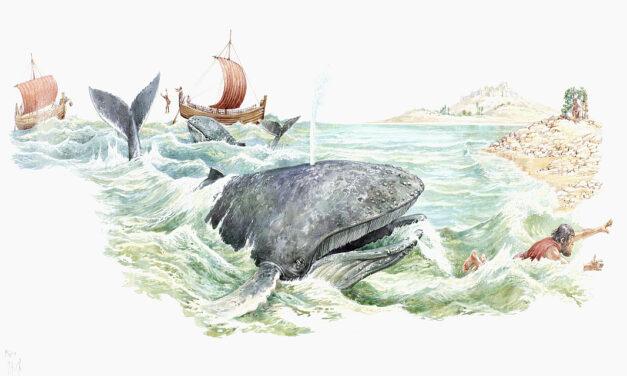This article first appeared in the Christian Research Journal volume 21, number 3 (1999). For further information about the Christian Research Journal, click here.
When they had crucified him, above his head they placed the written charge against him: THIS IS JESUS, THE KING OF THE JEWS. Those who passed by hurled insults at him, shaking their heads and saying, “You who are going to destroy the temple and build it in three days, save yourself! Come down from the cross, if you are the Son of God!”
In the same way the chief priests, the teachers of the law, and the elders mocked him — and the robbers who were crucified with him also heaped insults on him.
About the ninth hour, Jesus cried out in a loud voice, “Eloi, Eloi, lama sabachthani?” — which means, “My God, My God, why have you forsaken me?”
Then Jesus, knowing that the Passover plot was nearing completion, cried out, “I am thirsty.”
As if on cue, an unidentified friend of Joseph of Arimathea ran, filled a sponge with a sleeping potion, put it on a stick, and offered it to Jesus to drink.
When he had received it, Jesus cried out, “It is finished.” With that, he bowed his head and swooned.
Because the Jews did not want the bodies left on the crosses during the Sabbath, they asked Pilate to have the legs broken and the bodies taken down. But when they came to Jesus and found that he was apparently already dead, they did not break his legs. Instead, one of the soldiers pierced Jesus’ side with a spear.
As evening approached, Joseph of Arimathea went boldly to Pilate and asked for the body of Jesus. He took the body, wrapped it in a clean linen cloth and placed it in a tomb cut out of rock.
There Joseph and the unidentified Jew worked feverishly to nurse Jesus back to life.
Tragically, the Roman spear led to the death of Jesus and the virtual destruction of the Passover Plot. Jesus regained consciousness only long enough to cry out, “Do not let me die in vain. Deceive my disciples into believing I have overcome death and the grave.” With that, he bowed his head and died. Immediately Joseph and the unidentified Jew took the body of Jesus and disposed of it.
During the next forty days the unidentified Jew appeared to the disciples and through many convincing fabrications deluded them into believing that he was the resurrected Christ. Beginning with Moses and all the prophets he explained to them everything that the Scriptures had taught concerning the Messiah — how he should suffer, die, and be raised again. The hearts of the disciples burned within as they believed the lie. To this very day, the Passover Plot engineered by Jesus, Joseph, and the unidentified Jew continues to delude millions into believing that Jesus Christ has risen from the dead.1
Mythologies 27:22–41
Critical Theories
In 1965 Hugh Schonfield published a 287-page volume titled The Passover Plot.2 In this runaway bestseller, Schonfield contends that Jesus “deliberately plotted” His crucifixion and subsequent resurrection. According to The Passover Plot:
Jesus contrived to be arrested the night before the Passover, fully aware that he would be nailed to the cross the following day, but taken down before the onset of the Sabbath in accordance with Jewish law. He would survive the agony of but three hours on the cross.
To ensure his safe removal, he arranged to be given, while on the cross, not the traditional vinegar but a drug that would render him unconscious and make him appear dead. He would then be cut down from the cross in a deathlike trance, removed by accomplices to the tomb where he would be nursed back to health and then “resurrected.”3
This new interpretation of the life and death of Jesus captured the imagination of the world. Magazines and ministers immediately lauded it as perhaps the most important book published in a decade. Time magazine contended, “Schonfield does not discredit Christ. Instead, he argues that Christ was indeed the Messiah — the Son of Man, as he thought of himself, but not the Son of God — who had been foretold by Jewish prophets of old, and that this is glory enough.”4 Bible scholar William Barclay called The Passover Plot “a book of enormous learning and erudition, meticulously documented.”5
While the critics of historic Christianity have passionately proclaimed the virtues of Schonfield and his scholarship, The Passover Plot is little more than a novel regurgitation of swoon theories that were popular in the first half of the nineteenth century. As noted investigative journalist Lee Strobel points out in The Case for Christ, the swoon hypothesis is an urban legend that is continually being resuscitated.6
Swoon theorists dismiss the Resurrection by contending that Jesus never really died on the cross. Instead, He merely fainted and was later revived. A never-ending stream of imaginative stories has flowed from this basic thesis.
The swoon hypothesis is not the only novel notion critics of Christianity have used to explain away the Resurrection. Other hypotheses used to explain away the biblical account of the Resurrection emanate from world religions. One such theory is found in Islam. From a Muslim perspective, Jesus was never crucified and, thus, never resurrected.7 As Christian philosopher Norman Geisler explains, orthodox Muslims have traditionally held that “God made someone else look like Jesus and this person was mistakenly crucified as Christ.”8
Other theories on Jesus’ resurrection can be found in the kingdom of the cults. Jehovah’s Witnesses, for example, not only deny the deity of Jesus Christ but His bodily resurrection as well. They contend that God created Jesus as the archangel Michael; that He became merely human during His earthly sojourn; and that He was recreated as an immaterial spirit creature after His crucifixion.
A Gargantuan Fraud or the Greatest Feat in History
If liberal scholars, adherents of world religions, or devotees of the kingdom of the cults are correct, the biblical account of the Resurrection is either fiction, fantasy, or a gargantuan fraud. On the other hand, if Christianity is factually reliable, the Resurrection is the greatest feat in human history. As apologist Josh McDowell puts it, “After more than 700 hours of studying this subject, and thoroughly investigating its foundation, I have come to the conclusion that the resurrection of Jesus Christ is one of the ‘most wicked, vicious, heartless hoaxes ever foisted upon the minds of men, or it is the most fantastic fact of history.’”9 The apostle Paul made it crystal clear that no middle ground exists. The Resurrection is either history or hoax, miracle or myth, fact or fantasy:
If Christ has not been raised, our preaching is useless and so is your faith. More than that, we are then found to be false witnesses about God, for we have testified about God that he raised Christ from the dead. But he did not raise him if in fact the dead are not raised. For if the dead are not raised, then Christ has not been raised either. And if Christ has not been raised, your faith is futile; you are still in your sins. Then those also who have fallen asleep in Christ are lost. If only for this life we have hope in Christ, we are to be pitied more than all men. (1 Corinthians 15:14–19)
It is precisely because of the strategic importance of the Resurrection that each Christian must be prepared to defend its historicity. Apologetics — the defense of the faith — has a dual purpose. On the one hand, it involves pre–evangelism. In post-Christian America few people are aware that belief in the Resurrection is not a blind leap into the dark, but faith founded on fact. It is historic and evidential. Thus, it is defensible. On the other hand, it involves post-evangelism. During an age in which the Resurrection is under siege, knowing how to defend its reliability serves to strengthen our faith.
The Resurrection is not merely important to the historic Christian faith — without it there would be no Christianity. It elevates Christianity above all other world religions. Through the Resurrection, Christ demonstrated that He does not stand in a line of peers with Abraham, Buddha, Confucius, or Muhammad. Jesus Christ is utterly unique. He had the power not only to lay down His life, but also to take it up again.
Because of its centrality to Christianity, those who take the sacred name of Christ upon their lips must be prepared to defend the reliability of the Resurrection. To make the process memorable, I’ve developed the acronym F-E-A-T. Each letter in this acronym serves to underscore an undeniable fact of the Resurrection:
Fatal torment
Empty tomb
Appearances
Transformation
Fatal Torment
The fatal suffering of Jesus Christ is one of the most well-established facts of ancient history. Even in today’s modern age of science and technology, there is a virtual consensus among New Testament scholars, both conservative and liberal, that Jesus died on the cross, that He was buried in the tomb of Joseph of Arimathea, and that His death drove His disciples to despair.10 The best medical minds of ancient and modern times have demonstrated beyond a shadow of a doubt that Christ’s physical trauma was fatal.11
Taking into account today’s medical knowledge, we can reconstruct our Savior’s suffering. His torment begins in the Garden of Gethsemane after the emotional Last Supper. There Jesus experiences a medical condition known as hematidrosis. Tiny capillaries in His sweat glands rupture, mixing sweat with blood. As a result, Christ’s skin becomes extremely fragile.
The same night, Jesus is betrayed by Judas, disowned by Peter, and arrested by the temple guard. Before Caiaphas the High Priest, Jesus is mocked, spat upon, and beaten. The next morning, Jesus — battered, bruised, and bleeding — is led into the Praetorium. There He is stripped and subjected to the brutality of Roman flogging. A whip replete with razor sharp bones and lead balls reduces His body to “quivering ribbons of bleeding flesh.” As Christ slumps into the pool of His own blood, the soldiers throw a scarlet robe across His shoulders, thrust a scepter into His hands, and press sharp thorns into His scalp.
After the soldiers mock Jesus, they take the scepter out of His hand and repeatedly strike Him on the head. A heavy wooden beam is thrust upon Christ’s bleeding body, now in critical condition, and He is led away to a place called Golgotha. There the Lord experiences ultimate physical torture in the form of the cross. The Roman system of crucifixion had been finely tuned to produce maximum pain. In fact, the word excruciating (literally “out of the cross”) had to be invented to codify its horror.12
At “the place of the skull,” the Roman soldiers drive thick seven-inch iron spikes through Christ’s hands and feet. Waves of pain pulsate through His body as the nails lacerate His nerves. Breathing becomes an agonizing endeavor as Christ pushes His tortured body upward to gasp small gulps of air. In the ensuing hours He experiences cycles of joint-wrenching cramps, intermittent asphyxiation, and excruciating pain as His lacerated back moves up and down against the rough timber of the cross.
As the chill of death creeps through His body, Jesus cries out, “‘Eloi, Eloi, lama sabachthani?’ — which means, ‘My God, my God, why have you forsaken me?’” In that anguished cry is encapsulated the greatest agony of all. For on the cross Christ is bearing the sin and suffering of all humanity. Then with His passion complete, Jesus gives up His spirit.
Shortly thereafter a Roman legionnaire drives his spear through the fifth interspace between the ribs, upward through the pericardium and into Christ’s heart. Immediately, there rushes forth blood and water, demonstrating conclusively that Jesus has suffered fatal torment.
In light of all the evidence, to believe that Jesus merely swooned stretches credulity beyond the breaking point. It means that Christ survived six trials, lack of sleep, the scourge, being spiked to a cross, and a spear wound in His side.
Adherence to some of the more implausible versions of the swoon hypothesis would take even more faith. It would entail believing that Jesus survived three days without medical attention; single-handedly rolled away an enormously heavy tombstone; subdued an armed guard; strolled around on pierced feet; and seduced His disciples into communicating the myth that He had conquered death while He lived out the remainder of His pathetic life in obscurity.
Having established the fact that Jesus was fatally tormented, we now turn to the “E” in the acronym F-E-A-T, which will serve to remind us of the second undeniable fact supporting the Resurrection: The Empty Tomb.
Empty Tomb
The year 1985 marks the beginning of one of the most well-publicized wars in history — a war of words rather than weapons. It began with a coalition of “scholars” who dubbed themselves the Jesus Seminar. These scholars were determined to demolish the biblical Jesus in the public arena, rather than in private academia. Basically, they sought “to liberate the people of the church from the ‘dark ages of theological tyranny.’”13
Cofounder Robert Funk declared, “We want to liberate Jesus. The only Jesus most people know is the mythic one. They don’t want the real Jesus, they want the one they can worship. The cultic Jesus.”14
For his part, the other cofounder, John Dominic Crossan, took dead aim at the resurrection of Jesus Christ. Time magazine reports Crossan’s pontification: “The tales of entombment and resurrection were latter-day wishful thinking. Instead, Jesus’ corpse went the way of all abandoned criminals bodies: it was probably barely covered with dirt, vulnerable to the wild dogs that roamed the wasteland of the execution grounds.”15
At times the assertions of Jesus Seminar participants were so outrageous that the eminent Jewish scholar Jacob Neusner called the Jesus Seminar “either the greatest scholarly hoax since the Piltdown Man or the utter bankruptcy of New Testament studies — I hope the former.”16
Tragically, multitudes have uncritically accepted the assertions of the Jesus Seminar, failing to recognize that they fly in the face of well-established facts. Unlike a consensus of credible scholarship, Jesus Seminar scholars are famous for making dogmatic assertions while failing to provide defensible arguments. Christian philosopher and theologian William Lane Craig lamented, “It is sobering to think that it is this sort of idiosyncratic speculation that thousands of lay readers of magazines like Time have come to believe represents the best of contemporary New Testament scholarship concerning the historical Jesus.”17
As the reliability of the Resurrection is undermined in the media it is crucial that Christians are prepared to demonstrate that on Easter morning some two thousand years ago the tomb was indeed empty. Contrary to Crossan, the late liberal scholar John A. T. Robinson of Cambridge conceded that the burial of Jesus Christ “is one of the earliest and best-attested facts about Jesus.”18 As scholar D. H. van Daalen has noted, “It is extremely difficult to object to the empty tomb on historical grounds; those who deny it do so on the basis of theological or philosophical assumptions.”19 These statements are not merely dogmatic assertions but rather stand firmly upon sound argumentation.
First, both liberal and conservative New Testament scholars agree that the body of Jesus was buried in the private tomb of Joseph of Arimathea. Craig underscores this fact by noting that (1) “as a member of the Jewish court that condemned Jesus, Joseph of Arimathea is unlikely to be a Christian invention”; (2) “no competing burial story exists”; (3) the account of Jesus’ entombment is substantiated by Mark’s gospel and is, therefore, far too early to have been the subject of legendary corruption.20
Furthermore, as noted in The Case for Christ, “When you understand the role of women in first-century Jewish society, what’s really extraordinary is that this empty tomb story should feature women as the discoverers of the empty tomb.”21 Not only did women have low social status in Jewish society, but their testimonies were not even legally valid. “Any later legendary account would have certainly portrayed male disciples as discovering the tomb….This shows that the Gospel writers faithfully recorded what happened, even if it was embarrassing.”22
Finally, as Craig emphasizes in Jesus Under Fire, the earliest Jewish response to the Resurrection of Jesus Christ “presupposes the empty tomb.” Instead of denying that the tomb was empty, the antagonists of Christ accused His disciples of stealing the body. Their response to the proclamation, “He has risen – He is risen indeed” was not “His body is still in the tomb” or “He was thrown into a shallow grave and eaten by dogs.” Instead, they responded, “His disciples came during the night and stole him away.”23
In short, as Craig observes, early Christianity simply could not have survived an identifiable tomb containing the corpse of Christ. The enemies of Christ could have easily put an end to the charade by displaying the body, as depicted in the medieval Jewish polemic, Toledot Yeshu. Craig notes that even Jesus Seminar cofounder Crossan would be forced by the facts to concede that no one can affirm the historicity of Christ’s burial while simultaneously denying the historicity of the empty tomb.24
Having demonstrated that the empty tomb is an unassailable reality, we now turn to the letter “A” in the acronym F-E-A-T. This will serve to remind us of the third pillar supporting the Resurrection: The Appearances of Christ.
Appearances
In the Acts of the Apostles, Dr. Luke writes that Jesus gave the disciples “many convincing proofs that he was alive. He appeared to them over a period of forty days and spoke about the kingdom of God” (Acts 1:3). Likewise, Peter in his powerful Pentecost proclamation declared that many credible eyewitnesses could confirm the fact of Christ’s physical post-resurrection appearances:
Brothers, I can tell you confidently that the patriarch David died and was buried, and his tomb is here to this day. But he was a prophet and knew that God had promised him on oath that he would place one of his descendants on his throne. Seeing what was ahead, he spoke of the resurrection of the Christ, that he was not abandoned to the grave, nor did his body see decay. God has raised this Jesus to life, and we are all witnesses of the fact. (Acts 2:29–32; emphasis added).
Like the apostle Peter, the apostle Paul exudes confidence in the appearances of Christ. In his first letter to the Corinthian Christians, he provides details and descriptions:
For what I received I passed on to you as of first importance: that Christ died for our sins according to the Scriptures, that he was buried, that he was raised on the third day according to the Scriptures, and that he appeared to Peter, and then to the Twelve. After that, he appeared to more than five hundred of the brothers at the same time, most of whom are still living, though some have fallen asleep. Then he appeared to James, then to all the apostles, and last of all he appeared to me also, as to one abnormally born. (1 Corinthians 15:3–8; emphasis added)
One thing is sure. The apostles did not merely propagate Christ’s teachings; they were absolutely certain that He had appeared to them in the flesh. Although two thousand years removed from the actual event, we too can be absolutely confident in Christ’s post-resurrection appearances.
First, in the passage cited above, Paul is reiterating a Christian creed that can be traced all the way back to the formative stages of the early Christian church.25 Incredibly, scholars of all stripes agree that this creed can be dated to within three to eight years of the Crucifixion itself.26 The eminent scholar Joachim Jeremias calls this creed “the earliest tradition of all,” and Ulrich Wilckens says it “indubitably goes back to the oldest phase of all in the history of primitive Christianity.”27 Greco-Roman classical historian A. N. Sherwin White argues that it would be unprecedented historically for legend to have grown up that fast.28 Dr. Gary Habermas concludes that the creed is not only early but “that it’s free from legendary contamination, that it’s unambiguous and specific, and that it’s ultimately rooted in eyewitness accounts.”29
Furthermore, Peter, Paul, and the rest of the apostles claimed that Christ appeared to hundreds of people who were still alive and available for cross-examination (1 Cor. 15:6).30 It would have been one thing to attribute these supernatural experiences to people who had already died. It was quite another to attribute them to multitudes who were still alive. Suppose I announced publicly that I played a private round of golf with Arnold Palmer at Bay Hill County Club in Orlando. During the round I hit the longest drive Palmer had ever seen, made a hole-in-one, and set a new course record. As long as Palmer was living, my credibility could easily be called into question. Likewise, Paul’s assertions regarding the eyewitnesses who had seen the resurrected Christ could have easily been refuted if in fact they were not true.31
Finally, no one has ever come up with a credible means to explain away the post-resurrection appearances of Christ. As previously noted, the references to Christ’s appearances are early and free from legendary corruption. Thus, skeptics are often reduced to pawning them off as mere hallucinations.
In reality, as Habermas explains, hallucinations are subjective and scarce. Yet Christ appeared to many people over a long period of time. In addition, hallucinations are typically relegated to people with certain personality disorders, are stimulated by expectations, and do not stop abruptly. In the case of Christ, He appeared to all kinds of personality types with no expectations, and then the appearances stopped abruptly.32
Perhaps Professor Perrin, the late New Testament scholar at the University of Chicago said it best. In summing up the consensus of both liberal and conservative scholarship he wrote, “The more we study the tradition with regard to the appearances, the firmer the rock begins to appear upon which they are based.”33
At this point, there should be no doubt that Christ suffered fatal torment; that the empty tomb is a factual reality; and that Christ’s post resurrection appearances cannot be explained away as legends or hallucinations. We now move on to the final letter in the acronym F-E-A-T, which represents the word Transformation.
Transformation
What happened as a result of the Resurrection is unprecedented in all of history. In the span of 300 years, a small following of seemingly insignificant believers succeeded in turning an entire empire upside down and conquering it. As has been well said, “They faced the tyrants’ brandished steel, the lions’ gory mane, and the fires of a thousand deaths” because they were utterly convinced that they, like their Master, would one day rise from the grave in glorified, resurrected bodies. While it is conceivable that they would have faced torture, vilification, and even cruel deaths for what they fervently believed to be true, it is inconceivable that they would have been willing to die for what they knew to be a lie.
Peter, who was once afraid of a maid, after the Resurrection was transformed into a lion of the faith. According to tradition, he was crucified upside down because he felt unworthy to be crucified in the same manner as his Lord.34
James, the brother of Jesus, who once hated everything his brother stood for, after the Resurrection called himself a bondservant of Jesus Christ (James 1:1). He not only became the leader of the Jerusalem church, but in A.D. 62 was martyred for his faith.35 Eusebius of Caesarea describes how James was thrown from the pinnacle of the temple and subsequently stoned.36
Paul likewise was transformed. Once a ceaseless persecutor of the growing church, he became the chief proselytizer of the Gentile Christians.
Peter, James, and Paul were not alone. As Christian philosopher J. P. Moreland points out, within weeks of the Resurrection not just one but an entire community of at least ten thousand Jews was willing to give up the very sociological and theological traditions that had given them their national identity.37
To this day, Christ’s Resurrection continues to transform lives. Every day people of every tongue and tribe and nation are being baptized in the name of the risen Christ.
Recently, before the Garden Tomb in Jerusalem, I encountered a tourist who had no concept of the Resurrection’s significance. I explained to him that Christ had cloaked Himself in human flesh to restore the relationship with God broken by our sin; that in our behalf Christ had lived the perfect life that we could never live; and that He died for our sins, was buried, and on the third day rose again from the dead. I went on to explain that this was no mere fantasy but the most well-attested fact of ancient history. After communicating the F-E-A-T that demonstrates the fact of the Resurrection, this young man took the final step and personally experienced the resurrected Christ. Recognizing that he was a sinner, he repented of his sins and received Jesus Christ as Lord and Savior of his life.
Today he not only knows Christ evidentially, but he knows him experientially as well. Today Christ is more real to him than the very flesh on his bones.
Yes, Christ is risen indeed! In the inspired words of the apostle Paul, “He was delivered over to death for our sins and was raised to life for our justification” (Romans 4:25). —Hank Hanegraaff
Hank Hanegraaff is president of the Christian Research Institute, host of the Bible Answer Man broadcast and the Hank Unplugged podcast, and author of more than twenty books, including Truth Matters, Life Matters More: The Unexpected Beauty of an Authentic Christian Life (W Publishing Group, 2019).
NOTES
- Adapted from Matthew (NIV1984) but radically altered to accommodate Hugh Schonfield’s “Passover plot” hypothesis. All further Scripture quotations are from the NIV1984.
- Hugh J. Schonfield, The Passover Plot: A New Interpretation of the Life and Death of Jesus (New York: Bernard Geis Associates, 1965).
- Schonfield, The Passover Plot, inside front and back cover flaps.
- Schonfield, The Passover Plot, back cover.
- Schonfield, The Passover Plot.
- Lee Strobel, The Case for Christ (Grand Rapids: Zondervan, 1998), 192–93.
- See Qur’an 4:157–59.
- Norman L. Geisler and Abdul Saleeb, Answering Islam: The Crescent in Light of the Cross (Grand Rapids: Baker Books, 1993), 65.
- Josh McDowell, Evidence That Demands a Verdict (Arrowhead Springs, CA: Campus Crusade for Christ, 1972), 185.
- See Gary Habermas, The Historical Jesus (Joplin, MO: College Press, 1996), 143–70 (see especially 158); William Lane Craig, “Opening Address,” in Paul Copan, ed., Will the Real Jesus Please Stand Up? A Debate between William Lane Craig and John Dominic Crossan (Grand Rapids: Baker Books, 1998), 26–27.
- Except as noted, the following medical data and descriptions concerning Christ’s suffering are adapted from C. Truman Davis, “The Crucifixion of Jesus: The Passion of Christ from a Medical Point of View,” Arizona Medicine (Arizona Medical Association), March 1965, 183–87; and William D. Edwards, Wesley J. Gabel, and Floyd E. Hosmer, “On the Physical Death of Jesus Christ,” The Journal of the American Medical Association, 21 March 1986, 1455–63.
- Strobel, The Case for Christ, 197–98.
- Michael J. Wilkins and J. P. Moreland, “Introduction: The Furor Surrounding Jesus,” in Jesus Under Fire, ed. Michael J. Wilkins and J. P. Moreland (Grand Rapids: MI: Zondervan Publishing House, 1995), 2.
- Interview by Mary Rourke, “Cross Examination,” Los Angeles Times, February 24, 1994, E1, E5, as quoted in Wilkins and Moreland, “Introduction,” 2.
- Richard N. Ostling, “Jesus Christ, Plain and Simple,” Time, January 10, 1994, from the Time website, archived at https://web.archive.org/web/20010620004204/http://www.time.com/time/magazine/archive/1994/940110/940110.religion.html.
- Ostling, “Jesus Christ, Plain and Simple.”
- William Lane Craig, “Did Jesus Rise from the Dead?,” in Jesus Under Fire, ed. Michael J. Wilkins and J. P. Moreland (Grand Rapids: MI: Zondervan Publishing House, 1995), 142.
- John A. T. Robinson, The Human Face of God (Philadelphia: Westminster, 1973), 131, as quoted in Craig, “Opening Address,” 27.
- William Lane Craig, “Contemporary Scholarship and the Historical Evidence for the Resurrection of Jesus Christ,” Truth 1 (1985): 89–95, from the Leadership University web site at http://www.leaderu.com/truth/1truth22.html; see Wilkins and Moreland, 152.
- Craig, “Opening Address,” 26–27; Craig, “Did Jesus Rise from the Dead?,” 146–48; Craig, “Contemporary Scholarship and the Historical Evidence.”
- Strobel, The Case for Christ, 217.
- Strobel, The Case for Christ, 218.
- All material in this paragraph adapted from Craig, “Did Jesus Rise from the Dead?,” 152. See Matthew 28:13.
- All material in this paragraph adapted from Craig, “Did Jesus Rise from the Dead?,” 146–47.
- Craig, “Did Jesus Rise from the Dead?,” 147. In an interview with investigative journalist Lee Strobel, William Lane Craig notes that the confession used by Paul is exceedingly early and therefore trustworthy. Craig goes on to say that “essentially, it is a four-line quote. The first line refers to the crucifixion, the second to the burial, the third to the resurrection, and the fourth to Jesus’ appearances….This creed is actually a summary that corresponds line for line with what the gospels teach. When we turn to the Gospels, we find multiple, independent attestation of this burial story, and Joseph of Arimathea is specifically named in all four accounts. On top of that, the burial story in Mark is so extremely early that it’s simply not possible for it to have been subject to legendary corruption” (Strobel, The Case for Christ, 209).
- Habermas, The Historical Jesus, 154. See also Craig L. Blomberg, “Where Do We Start Studying Jesus?,” in Jesus Under Fire, ed. Michael J. Wilkins and J. P. Moreland (Grand Rapids: MI: ZondervanPublishingHouse, 1995), 43.
- Strobel, The Case for Christ, 230.
- William Lane Craig, Reasonable Faith (Wheaton: Crossway Books, 1994), 285.
- Strobel, The Case for Christ, 233.
- Cf. Craig, “Did Jesus Rise from the Dead?,” 153. Paul received this creed from the believing community (v. 3), perhaps from Peter and James in Jerusalem (Gal. 1:18–19), if not sooner (see Habermas, The Historical Jesus, 155).
- Paul’s first letter to the Corinthians is dated at about A.D. 55; that is, 25 years after Christ’s crucifixion and resurrection. His statement that “most [of the eyewitnesses] are still living” (1 Cor. 15:6) is what one would expect.
- See Lee Strobel’s interview with Gary Habermas in The Case for Christ, 238–40.
- Norman Perrin, The Resurrection According to Matthew, Mark, and Luke (Philadelphia: Fortress, 1977), 80, as quoted in Craig, “Opening Address,” 28.
- See Eusebius, History of the Church, Book II:XXV; Book. III:I; Clement of Rome, First Epistle to the Corinthians, ch. 5.
- Kenneth Barker, gen. ed., The NIV Study Bible (Grand Rapids: Zondervan, 1985), 1879. See F. L. Cross and E. A. Livingstone, eds., The Oxford Dictionary of the Christian Church, 2d ed. (Oxford: Oxford University Press, 1990), 722.
- Eusebius, Bk. II: XXIII. Cf. Josephus, Antiquities, 20:9:1; see John P. Meier, A Marginal Jew: Rethinking the Historical Jesus, vol. 1 (New York: Doubleday, 1991), 57–59.
- Strobel, The Case for Christ, 251.
***Please note the formatting has been updated and corrections made from the original print publication.***









